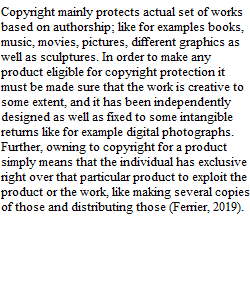


Q Former FIT design student Francis Bitonti has designed a dress to be produced by 3D printing. Let us assume that in this case the dress has an interesting architectural feature -- if you plant it down on the floor, it stands up and holds its shape. It is composed of soft plastic links that when linked together form a semi-rigid structure. While it can move and stretch slightly when worn, it is a little like a suit of armor in that it does not collapse when taken off -- it retains its original form. Bitonti wishes to mass produce this dress so he seeks to copyright it as both sculpture and as apparel. The Copyright Office refuses the registration application on the grounds that apparel is not copyrightable. He appeals. As a court, how would you analyze Bitonti's case? Is he on stronger grounds than Whimsicality, Chosun, Jovani orKieselstein? Why or why not?
View Related Questions